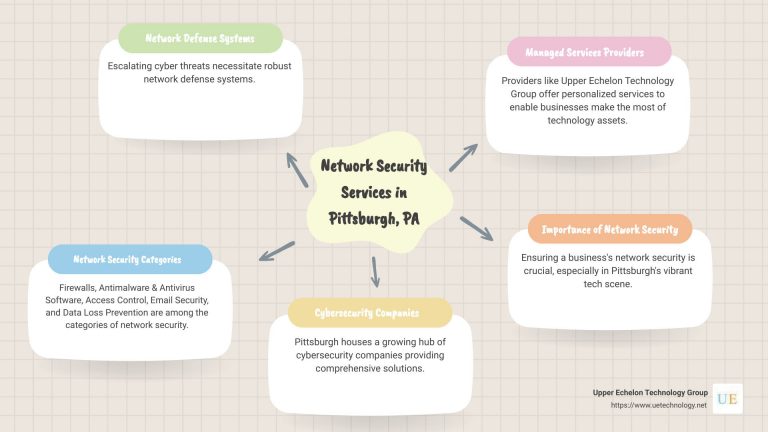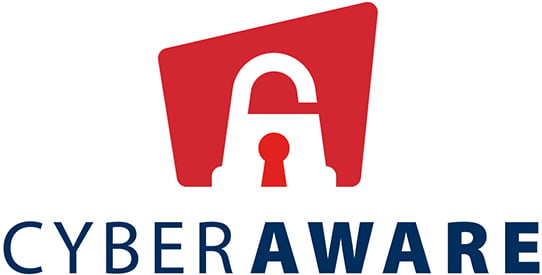Introduction: The Importance of Information Security Program Assessments
Picture this: It’s a regular Monday morning at your bustling Wilmington business, but suddenly your servers crash, and sensitive data is compromised. The culprit? A gap in your cybersecurity regime that you never knew existed. While attempting to get your servers back online and manage the fallout, you cringe at the thought of how this can be potentially devastating to your business operations and reputation. You now realize that this could have been prevented with a thorough information security program assessment.
At Upper Echelon Technology Group, we can’t stress enough the importance of conducting regular information security program assessments. It is an invaluable tool that helps small to medium-sized businesses like yours identify potential risks and implement necessary controls to shield against cyber threats. But what really is an information security program assessment?
In simplest terms, an information security program assessment is an objective evaluation of your security protocols against recognized industry standards. The assessment peels back the layers of your cybersecurity measures to determine their maturity, performance, and application scope. Through identifying security gaps, the assessment helps bolster your defenses, fortifying your business against breaches.
But don’t just take our word for it. Refer to this quick information snippet to get a sense of its foundational elements:
- Maturity of the Solution: Checking your cybersecurity measures to determine how advanced and capable they are in addressing threats.
- Performance of the Solution: Verifying how effective the cybersecurity measures are in meeting the desired level of security.
- Scope of Application of the Solution: Understanding the extent and reach of your cybersecurity measures across your business operations.
Now let’s dive into these elements in detail to truly understand their importance.
For a more extensive understanding of the topic, make sure to visit our comprehensive overview on cyber security risk assessments.
Understanding Information Security Program Assessments
Information security program assessment plays a critical role in safeguarding your business. But what exactly is it? How does it contribute to cybersecurity? And what are the three dimensions of security control effectiveness? Let’s unpack these questions.
What is a Security Program Assessment?
In simple terms, a security program assessment is an objective evaluation of your security measures against the preferred security standard in your industry. We at Upper Echelon Technology Group focus on three core dimensions while conducting these assessments: the maturity of your solution, how well it meets control expectations, and its scope of application.
The Role of Security Program Assessment in Cybersecurity
Security program assessments are an integral part of cybersecurity. They help identify any vulnerabilities or loopholes in your security measures that could be exploited by cyber attackers. By regularly conducting these assessments, we can ensure that your company’s security measures are up-to-date and effective against current threats.
The Three Dimensions of Security Control Effectiveness
Now, let’s delve deeper into the three dimensions of security control effectiveness.
-
Maturity of the Solution: This refers to how advanced and up-to-date your security measures are. Mature solutions are more likely to protect your business from sophisticated cyber threats.
-
Performance of the Solution to the Controls Expectation: It’s not enough to have advanced security measures in place. They also need to perform effectively, meeting or exceeding the expectations set by the control measures.
-
Scope of Application of the Solution: Lastly, the scope of application refers to how extensively your security measures are applied across your business operations. The wider the scope, the more comprehensive your protection.
Understanding these dimensions and how they apply to your business is crucial for mastering information security program assessments. They provide a comprehensive picture of your current security status and help identify areas for improvement.
Remember, cybersecurity is a dynamic field, with new threats emerging regularly. Regular assessments ensure that your business stays one step ahead, minimizing risks and safeguarding your valuable data.
For more related topics, visit our subtopic pages such as cybersecurity program assessment and risk assessment in cyber security.
In the next section, we’ll delve into the process of conducting an information security program assessment. Stay tuned!
The Process of Conducting an Information Security Program Assessment
At Upper Echelon Technology Group, we believe that understanding the process of an information security program assessment is vital in achieving a robust cybersecurity posture. This process involves three main steps: evaluating the maturity of the solution, assessing the performance of the solution to the controls expectation, and understanding the scope of application of the solution.
Evaluating the Maturity of the Solution
The first step in an information security program assessment is to evaluate the maturity of your security solution. This involves analyzing your current security measures and identifying areas that need improvement.
Maturity in this context refers to how advanced or developed your security measures are. It’s not just about having security controls in place, but how well these controls are integrated into your everyday business operations.
For example, do you have a well-documented incident response plan? Are your employees trained to recognize and respond to security threats? These are some of the questions that can help determine the maturity of your security solution.
Assessing the Performance of the Solution to the Controls Expectation
Once you’ve evaluated the maturity of your security solution, the next step is to assess its performance against the controls expectation. This means comparing your security measures to industry standards or best practices.
In this stage, it’s crucial to not just focus on whether your security controls are in place, but also on how effectively they are performing. Are they achieving the desired outcome? Are there any gaps or weaknesses that need to be addressed?
At Upper Echelon Technology Group, we use industry-recognized frameworks like ISO 27002:2013 and NIST 800-53 r4 Controls to guide this assessment.
Understanding the Scope of Application of the Solution
The final step in the assessment process is understanding the scope of the application of your security solution. This involves identifying all the areas of your business that your security measures cover.
It’s important to note that the scope should not be limited to just your IT systems. It should also cover other areas like physical security, employee training, and business processes. In the same vein, it’s also important to identify any areas that may be left unprotected and plan for how to address these gaps.
In conclusion, conducting an information security program assessment is a complex but crucial process. It helps you understand the current state of your security measures, identify areas for improvement, and plan for the future.
Remember, cybersecurity is not a one-time task but a continual process. Regular assessments and improvements are key to staying ahead of the ever-evolving threat landscape.
For more insights into the world of cybersecurity assessments, check out our cyber risk analysis and cyber security assessment pages.
Key Assessments in Information Security
After understanding the importance and role of information security program assessment, it’s crucial to familiarize yourself with the various assessments involved in the process. At Upper Echelon Technology Group, we focus on five key assessments to ensure comprehensive security coverage.
Application Vulnerability Assessment
First on the list is the Application Vulnerability Assessment. This assessment aims to identify, assess, and implement key security controls in applications. It’s particularly crucial in preventing application security defects and vulnerabilities, thereby allowing us to view the application portfolio holistically—from an attacker’s perspective.
Enterprise Security Assessment
Next is the Enterprise Security Assessment. This is a broad assessment that covers an organization’s entire security framework. It evaluates not only the technical aspects but also the organization’s security policies, procedures, and practices. This holistic approach ensures that all potential weaknesses are identified and addressed.
Host-Based Security Assessment
The Host-Based Security Assessment is a more focused assessment that scrutinizes individual systems within an organization’s network. It checks for vulnerabilities that could be exploited by malicious entities and recommends countermeasures to mitigate these risks.
Network-Based Security Assessment (Attack and Penetration)
Our Network-Based Security Assessment, also known as Attack and Penetration, simulates a real-world cyberattack on your network to identify vulnerabilities. This proactive approach provides invaluable insights into potential weak points before they can be exploited by actual attackers.
Physical Security Assessment
Lastly, the Physical Security Assessment evaluates the physical measures in place to protect your organization’s information systems and data. This includes checks on access control, surveillance systems, and even the structural integrity of the facilities housing your IT infrastructure.
At Upper Echelon Technology Group, we believe that a comprehensive approach to cybersecurity is the best defense against potential threats. We ensure that every facet of your organization’s security—be it application, enterprise, host, network, or physical—is thoroughly evaluated and fortified.
For more information on how we conduct these assessments, check out our page on cybersecurity program assessment. And if you’re interested in seeing an example of a risk assessment, head over to our cybersecurity risk assessment example page.
Remember, no matter the size of your business, your information security is crucial to your success. Don’t leave it to chance—get assessed, get protected.
The Role of Security Assessment Report (SAR) in Information Security Program Assessment
Let’s dive a little deeper into one key component of the information security program assessment: the Security Assessment Report (SAR).
Understanding SAR Assessment
A Security Assessment Report (SAR) is a crucial part of your overall cybersecurity strategy. This detailed document lays out the results from your security assessments, providing a thorough and comprehensive look at your current security status.
The SAR isn’t just a list of findings—it’s a roadmap to improved security. It objectively evaluates your security controls, highlights vulnerabilities, and provides a clear action plan for enhancing your security measures.
How SAR Presents Findings from Security Assessments
The SAR details the findings from all the different assessments conducted, including Application Vulnerability, Enterprise Security, Host-Based Security, Network-Based Security (Attack and Penetration), and Physical Security Assessments.
The report is precise, detailed, and easy to understand. It gives you a clear picture of where your security stands, what gaps exist, and how to address them. Importantly, it provides insights from an attacker’s perspective, allowing you to anticipate potential threats and address them proactively.
Recommendations to Address Vulnerabilities or Deficiencies Found in SAR
But a SAR is not just about identifying problems—it’s also about offering solutions. The report provides recommendations to address any vulnerabilities or deficiencies uncovered during the assessments.
These recommendations are tailored to your unique business needs and situation, offering practical, actionable steps to improve your cybersecurity. Whether it’s updating software, strengthening passwords, or improving physical security measures, the SAR provides clear guidance on how to enhance your cybersecurity.
At Upper Echelon Technology Group, we’re not just here to identify your technology issues—we’re here to solve them. We understand that every business is unique, and we tailor our recommendations to your specific needs.
With our personalized approach to IT Managed Services, we can help you leverage your technology assets in the best way possible. From conducting detailed SAR assessments to implementing recommended improvements, we’re here to help you strengthen your cybersecurity and safeguard your business.
Learn more about our approach to cybersecurity on our cybersecurity risk assessments page. If you’re interested in how we conduct assessments, visit our cybersecurity program assessment page. And to see how we’ve helped other businesses like yours, check out our cybersecurity risk assessment example page.
With Upper Echelon Technology Group, you can rest assured knowing your information security is in good hands.
Information Security Risk Assessment Program: A Crucial Part of Information Security Program Assessment
Understanding the risk landscape is a pivotal step in any information security program assessment. At Upper Echelon Technology Group, we prioritize this process, ensuring that every possible risk scenario is examined and prepared for.
Identifying, Assessing, and Implementing Key Security Controls in Applications
To fortify your company’s defenses, we begin by identifying, assessing, and implementing key security controls in applications. This involves a comprehensive examination of your cybersecurity infrastructure, evaluating the effectiveness of existing security measures, and identifying areas that need improvement.
Our expert team is adept at recognizing potential vulnerabilities and threats, whether they are internal or external, intentional or accidental. We then work to implement tailored security controls that address these specific threats. This can involve anything from enhancing password protection to implementing advanced firewall technology.
The Role of Risk Assessment in Preventing Application Security Defects and Vulnerabilities
Risk assessment plays a crucial role in preventing application security defects and vulnerabilities. By conducting thorough and regular risk assessments, we can identify potential security issues before they become a problem.
As part of our information security program assessment, we work to understand the unique challenges and threats that your business faces. This allows us to develop a comprehensive risk profile that can be used to guide our security efforts.
Viewing the Application Portfolio Holistically—From an Attacker’s Perspective
One of the key strategies we employ in our risk assessment process is to view your application portfolio from an attacker’s perspective. This approach allows us to identify potential weaknesses that might be exploited, and to put measures in place to prevent breaches.
By adopting the viewpoint of a potential attacker, we can anticipate their strategies and tactics. This allows us to develop effective defense mechanisms that can protect your business from a wide range of cybersecurity threats.
In conclusion, our holistic approach to information security program assessments ensures that every aspect of your business’s cybersecurity is robust and effective. By identifying potential threats, assessing risks, and implementing appropriate security controls, we help you safeguard your business against the ever-evolving world of cybersecurity threats.
Check out our cyber risk assessment and management page, to learn more about how we can help protect your business.
The Importance of Regular IT Risk Assessments
Here at Upper Echelon Technology Group, we strongly emphasize the importance of regular IT risk assessments as a vital part of any comprehensive information security program assessment.
Identifying Threats to Information Systems, Networks, and Data
The digital landscape is constantly evolving, with a cyber attack attempted every 40 seconds and ransomware attacks increasing by a shocking 400% year on year. This fast-paced environment underscores the need to proactively identify threats to your information systems, networks, and data.
We work closely with you to uncover potential threats and pinpoint the areas in your systems that are most vulnerable. This way, we’re not just solving your tech issues; we’re helping you prevent them.
Assessing the Potential Consequences of Threats
Aside from identifying threats, a regular IT risk assessment also involves assessing the potential consequences should these adverse events occur. This process helps us to understand the scale of the impact on your business if critical systems were to go down.
Knowing the financial and operational implications of such risks allows us to allocate resources effectively to your security program. This strategic approach ensures your business remains resilient in the face of potential cyber threats.
The Role of Risk Assessments in Compliance with Information Security Frameworks
Beyond protection and resource allocation, regular IT risk assessments are also crucial for maintaining compliance with information security frameworks, such as ISO 27001 and CMMC. Meeting these requirements isn’t just about ticking boxes, it’s about demonstrating to your stakeholders that you take security seriously and have robust measures in place.
At Upper Echelon Technology Group, we’re committed to helping you navigate these requirements and ensuring your business is always up-to-date and compliant.
We understand that risk assessments can seem daunting, especially if you’re a small to medium-sized business owner. That’s why we’re here to guide you every step of the way. If you’re keen to learn more about our approach to risk assessments and how they fit into a broader information security program assessment, we’d love to chat.
Conclusion: The Future of Information Security Program Assessments
As we wrap up this comprehensive guide, it’s clear that information security program assessments are not just a passing trend, but rather a crucial aspect of modern business. With the digital world evolving at an unprecedented rate, the need for robust and comprehensive cybersecurity measures is more important than ever.
Information security program assessments are set to become even more central. As threats become more complex, the assessments will likely evolve to incorporate advanced predictive analytics, AI, and machine learning to proactively identify potential vulnerabilities.
But don’t let these advancements intimidate you. We’re here to help. At Upper Echelon Technology Group, we’re committed to staying on the cutting edge of cybersecurity trends and ensuring our clients’ digital assets are secure.
Embracing the Future, Together
We understand that navigating the world of cybersecurity can feel overwhelming. That’s why we’re here to guide you. Our team of experts can help you understand and implement an information security program assessment that is tailored to your business needs.
We’re not just about fixing tech issues. We’re about partnering with businesses like yours to leverage technology in the best way possible. Whether it’s identifying areas where technology can improve your bottom line or making your team more efficient, we’ve got your back.
Staying Ahead in the Cybersecurity Game
At Upper Echelon Technology Group, we believe in staying ahead of the curve. We’re constantly updating our knowledge and skills to ensure we provide the best possible service to our clients. As the future of information security program assessments unfolds, we’ll be there, ready to help you navigate the landscape.
To learn more about how we can assist your business in its cybersecurity journey, don’t hesitate to reach out to us. Let’s work together to secure and grow your business in this digital age.
Remember, cybersecurity isn’t a destination, it’s a journey. And we’re here to make that journey as smooth and secure as possible. Here’s to a secure future!
We hope you found this guide informative and useful. For more insights on cybersecurity risk assessments, visit our topic overview page or explore our other subtopic pages related to cybersecurity risk assessments.
Until next time, stay safe and secure!







